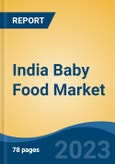Speak directly to the analyst to clarify any post sales queries you may have.
10% Free customizationThis report comes with 10% free customization, enabling you to add data that meets your specific business needs.
Key Market Drivers
Rising Urbanization and Changing Lifestyles
India’s accelerating urbanization has transformed family structures and consumer behavior, providing strong momentum for the baby food sector. As of 2024, the urban population has reached 461 million, growing at 2.3% annually, with cities expected to generate 75% of national income by 2031. The shift toward nuclear families and dual-income households in urban areas has created strong demand for convenient and nutritionally sound baby food options. Parents in cities increasingly rely on ready-to-consume baby foods to balance busy routines while ensuring infant health. This lifestyle transformation, coupled with greater exposure to modern retail and digital platforms, continues to drive adoption of packaged baby food in tier-1 and metro cities across the country.Key Market Challenges
Cultural Preference for Homemade Baby Food
A key hurdle for India’s baby food market is the enduring cultural preference for homemade baby food. Especially in rural and semi-urban households, fresh and customized meals made from locally sourced ingredients remain the norm. Many families, guided by traditional beliefs and older generations, perceive homemade food as safer and more nutritious than packaged alternatives. Common ingredients like mashed lentils, fruits, and rice are trusted for being natural and preservative-free. This ingrained habit presents a challenge for brands attempting to convert these consumers, especially when concerns about added sugars, preservatives, and synthetic flavors in commercial baby food persist. Overcoming this skepticism will require brands to emphasize transparency, nutritional safety, and ingredient sourcing through focused education and outreach.Key Market Trends
Shift Towards Organic and Natural Baby Food Products
A major trend shaping the baby food market in India is the increasing inclination toward organic and natural products. Parents are becoming more mindful of potential risks from pesticides, GMOs, and artificial additives, driving demand for cleaner, safer nutrition. This shift has led to the rise of organic baby food brands offering cereals, purees, and snacks made from certified ingredients. These offerings often highlight their sustainability, ethical sourcing, and nutritional value, catering to modern, health-conscious parents. With expanded presence in organized retail and e-commerce, these products are gaining traction beyond metropolitan hubs. While urban adoption is strong, price and awareness continue to be barriers in rural markets, underscoring the need for consumer education to support long-term growth.Key Market Players
- Nestle India Limited
- Gujarat Cooperative Milk Marketing Federation Ltd.
- Abbott India Limited
- Manna Foods Private Limited
- Nutricia International Private Limited
- Mead Johnson Nutrition India Pvt. Ltd.
- Pristine Organics Pvt. Ltd
- Raptakos Brett & Co.
- Safety Foods Pvt. Ltd.
- British Life Sciences
Report Scope:
In this report, the India Baby Food Market has been segmented into the following categories, in addition to the industry trends which have also been detailed below:India Baby Food Market, By Product Type:
- Milk Formula
- Dried Baby Food
- Prepared Baby Food
- Others
India Baby Food Market, By Sales Channel:
- Supermarkets/Hypermarkets
- Convenience Stores
- Online
- Others
India Baby Food Market, By Region:
- North
- South
- East
- West
Competitive Landscape
Company Profiles: Detailed analysis of the major companies present in the India Baby Food Market.Available Customizations:
With the given market data, the publisher offers customizations according to a company's specific needs. The following customization options are available for the report.Company Information
- Detailed analysis and profiling of additional market players (up to five).
This product will be delivered within 1-3 business days.
Table of Contents
Companies Mentioned
- Nestle India Limited
- Gujarat Cooperative Milk Marketing Federation Ltd.
- Abbott India Limited
- Manna Foods Private Limited
- Nutricia International Private Limited
- Mead Johnson Nutrition India Pvt. Ltd.
- Pristine Organics Pvt. Ltd
- Raptakos Brett & Co.
- Safety Foods Pvt. Ltd.
- British Life Sciences
Table Information
| Report Attribute | Details |
|---|---|
| No. of Pages | 85 |
| Published | April 2025 |
| Forecast Period | 2024 - 2030 |
| Estimated Market Value ( USD | $ 5.95 Billion |
| Forecasted Market Value ( USD | $ 8.4 Billion |
| Compound Annual Growth Rate | 5.9% |
| Regions Covered | India |
| No. of Companies Mentioned | 10 |









